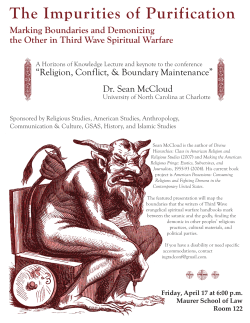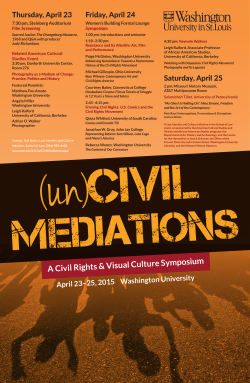
Lecture10 AND 11_MEDA101_2014 Construction of Space (in
Next Session MEDA102 We look at: Computational media art as a set of instructions (eg. Sol LeWitt) = iterations and repetitions (eg Warhol’s Marilyn Diptych) We do some knitting We do some very simple programming MEDA101 ! Lecture 10! Etienne Deleflie Sequence / Framing / Narrative [Daniel Clowes, David Boring, 2000] We look at how to build a narrative with: sequences (time) framing" [Scott McCloud, Understanding Comics, 1993] * = hint on a technique to explore for assignment 3 Film [Sergio Leone, The Good, the Bad, and the Ugly 1967] Graphic Novel / Comics [Pat Grant, Blue 2012, http://www.boltonblue.com/ ] Ciné-roman: A hybrid comic / film mode * [Chris Marker, La Jetée 1965] La Jetée as a book? … hmm, what will be lost? [Scott McCloud, Understanding Comics, 1993] * An establishing shot (or sequence), part of the grammar of ‘sequential art’ McCloud describes reading comics as the act of constantly ‘closing’ the gap between each frame." ! representation interpretation [Scott McCloud, Understanding Comics, 1993] analogous with my concept of ‘interpretation’ within aesthetic movement representation < ——— > interpretation [ Charlie Brown comic strip, 1950 ] Graphic novels / comic strips “provide very little data about any particular moment in time, or aspect in space, of an object. The viewer, or reader, is compelled to participate in completing and interpreting the few hints provided by the bounding lines” Marshall McLuhan representation < ——— > interpretation “few hints” “viewer compelled to complete” [ p.161, Marshall McLuhan. Understanding Media: The Extensions of Man. Cambridge, Massachusetts: The MIT Press, 1994. ] Gaps between images The bigger the gaps, the more we participate in the making of meaning Gaps in: • time (an instant, a day, a year) • subject matter (baseball, planet) • scale • framing • etc. [Scott McCloud, Understanding Comics, 1993] interpret this gap! * * * [Scott McCloud, Understanding Comics, 1993] * * * [Scott McCloud, Understanding Comics, 1993] [Scott McCloud, Understanding Comics, 1993] [Scott McCloud, Understanding Comics, 1993] [Scott McCloud, Understanding Comics, 1993] Scene to scene" We read that there is a big time gap The use of a black frame between the two helps us interpret that time gap. It suggests ‘darkness’ (as in night), but also darkness as in frightening, unknown, difficult, foreign [Daniel Clowes, David Boring, 2000] The non-sequitur pushes the aesthetic experience (or the construction of the narrative) right over into interpretation representation ——— > interpretation [Scott McCloud, Understanding Comics, 1993] ‘The Kuleshov Effect’ ⁃ huge gaps between images ⁃ juxtapositions of the image create meanings not inherent in the images by themselves http://www.youtube.com/watch?v=JlrHrrFv-Qk&list=PLD57E1B8B1E71D846 Lets consider more filmic techniques that might be applied to a ciné-roman Very early film had no notion of editing [Dickson, Blacksmith Scene, 1893] Editing techniques: ! 1. Elliptical editing … compresses time 2. Overlapping actions or cutaways … expands time 3. Inter-cutting, cross-cutting or parallel edits … simultaneous action 4. Sequencing … setup diegetic space diegetic space: a narrative that is being recounted * 1. Elliptical editing compresses time [John G. Avildsen, Rocky, 1976] http://www.youtube.com/watch?v=6l8cXMGimeU&list=PLD57E1B8B1E71D846 * 2. Overlapping actions or cutaways expand or dilate time [Sergei Eisenstein, The Battleship Potempkin, 1925] https://www.youtube.com/watch?v=laJ_1P-Py2k start at 4:37 * 3. Inter-cutting, cross-cutting or parallel edits portray simultaneous action [Edwin Porter, The Great Train Robbery, 1903] http://www.youtube.com/watch?v=BHxFjcxYpuE%20&feature=related * 4. Sequencing to construct diegetic (narrative) space [Yasujiro Ozu, An Autumn Afternoon (Sanma no aji), 1962] https://www.youtube.com/watch?v=X4j-8X0B7rs&list=PLD57E1B8B1E71D846 framing Framing in film is different to framing in photography In film, the framing of space is in relation to the construction of the narrative more so than the independent composition of that frame. Convention of framing or construction of shots Long shot LS ⁃ Commonly used as establishing shot (establishes the scene/ location in the audience’s mind) ⁃ Showing the scene and the context ⁃ Variations: extreme long shot, wide shot ! Mid shot MS ⁃ Showing partial view of the person/ object ⁃ Imparting some details such as spatial expression and body language ⁃ As well as the context ⁃ Variations: American, 3/4 ! Close-up CU ⁃ Tight framing on the subject ⁃ Convey details of the subject without showing the context ⁃ Commonly to show expressions (reaction, emotion etc.) ⁃ Variations: extreme close-up xcu * Long Shot [Chris Marker, La Jetée 1965] * Mid Shot [Chris Marker, La Jetée 1965] * Close Up [Chris Marker, La Jetée 1965] WS, MS, CU, XCU WS MS MS Note: start and end on Long/wide shot MS XCU CU XCU XCU WS [Daniel Clowes, David Boring, 2000] * Two shots ⁃ Convey interaction/ dialogue between two (or more) characters ⁃ Shot-Reverse Shot structure ⁃ We assume we are seeing from the character’s eyeline ⁃ We assume they are talking to each other ⁃ We assume when they look off screen, they are looking at the other person ⁃ There is no mistake/ confusion who is talking to who [The Dark Knight, Christopher Nolan, 2008] * Hitchcock’s Rule Pioneer of the suspense / thriller genre ^ [ p.25. Brown, B. (2012). Cinematography: Theory and Practice: Imagemaking for Cinematographers and Directors. Taylor & Francis. ] “The size of an object in the frame should equal its importance in the story at that moment“ ^ [Daniel Clowes, David Boring, 2000] [ Psycho, Hitchcock, 1960 ] What is behind the curtain? [ Indiana Jones, George Lucas, 1981 He has a gun! [ Touch of Evil,Orson Welles, 1958] Consider relative size (in frame) of the • • “The size of an object in the frame should equal its importance in the story at that moment“ ^ https://www.youtube.com/watch?v=Yg8MqjoFvy4#t=37 • bomb car street scene [Sergio Leone, The Good, the Bad, and the Ugly 1967] https://www.youtube.com/watch?v=XP9cfQx2OZY&list=PLM8qNXfQpWV3THusRuV6jFOdM60l1sJzG start at : 4:20 * Offscreen Space Just as we “close” the gap between frames, we also fill-in what lies off-screen. [Scott McCloud, Understanding Comics, 1993] Off-screen space is often: ⁃ implied using eyeline (e.g. character looks off screen at something) ⁃ this is used in two-shot ⁃ most effective in horror or suspense films < Character hears a sound Viewers are given plenty of time to allow much interpretation [Alfred Hitchcock’s Rear Window] https://www.youtube.com/watch?v=t8eNpwLPwog&list=PLM8qNXfQpWV3THusRuV6jFOdM60l1sJzG Use different types of gaps between your images (time, subject matter, scene, etc.) Explore and exploit the large lexicon of filmic techniques … but also subvert and challenge it
© Copyright 2025









